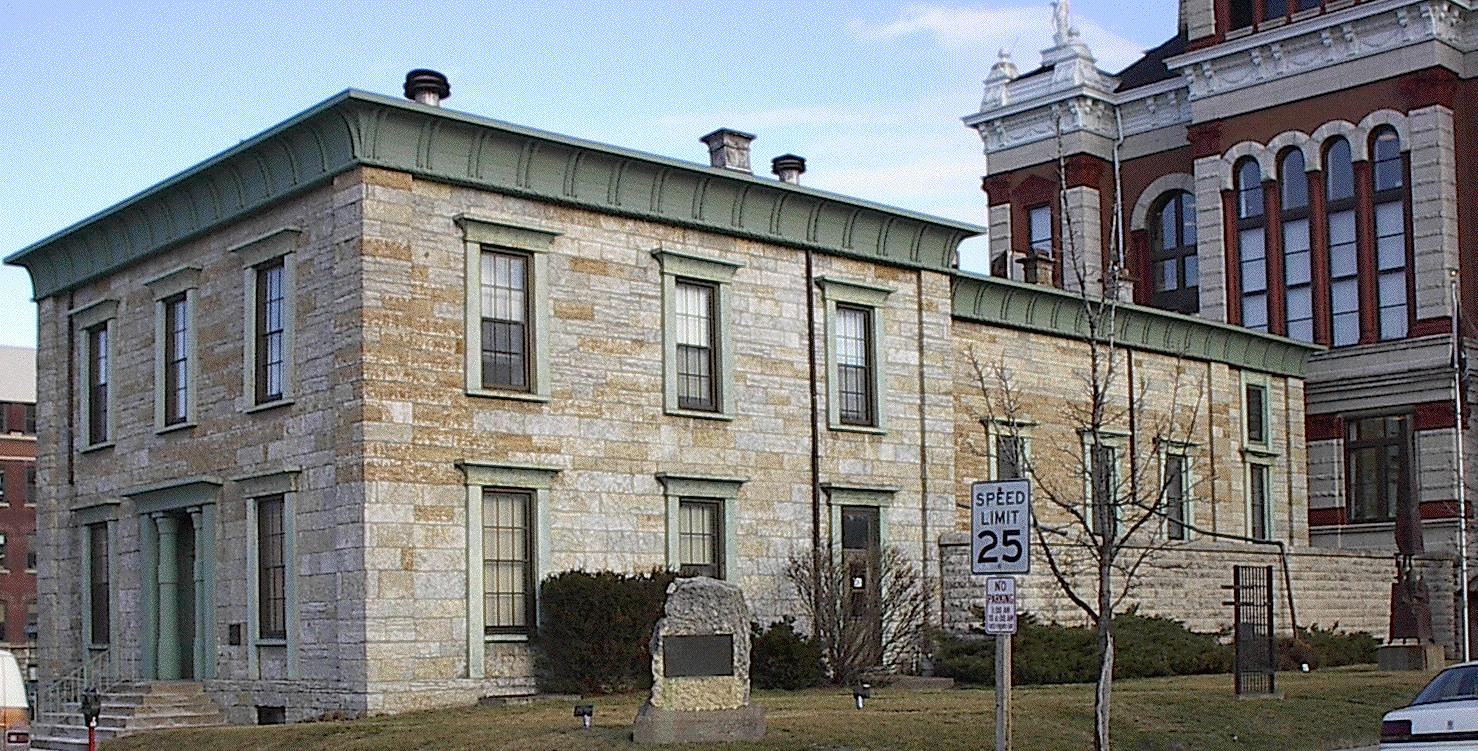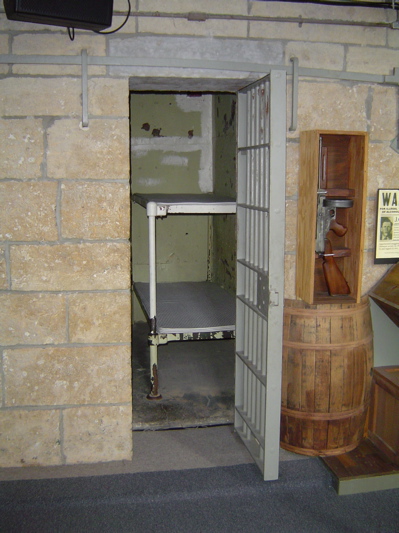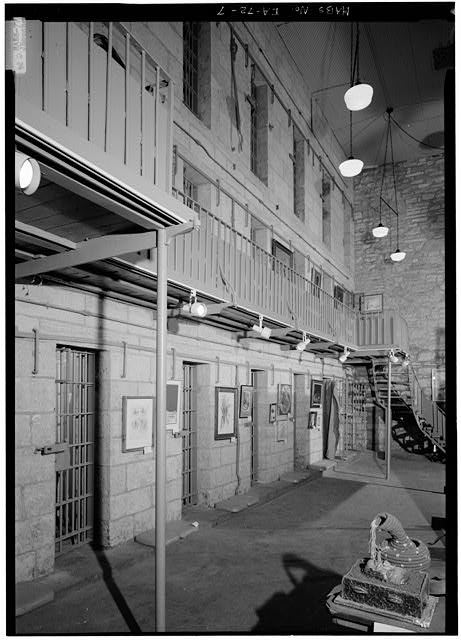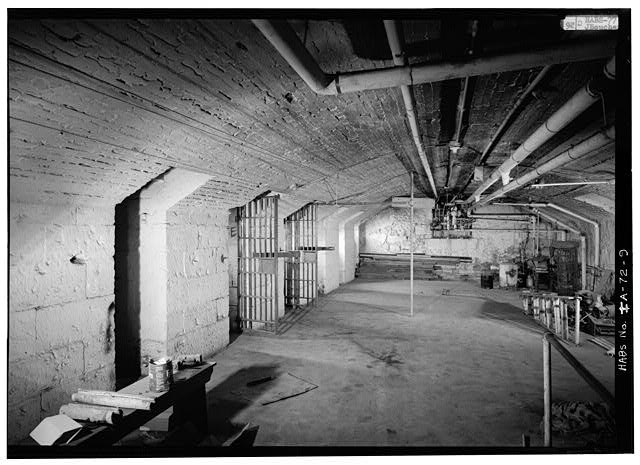Encyclopedia Dubuque
"Encyclopedia Dubuque is the online authority for all things Dubuque, written by the people who know the city best.”
Marshall Cohen—researcher and producer, CNN
Affiliated with the Local History Network of the State Historical Society of Iowa, and the Iowa Museum Association.
OLD JAIL
OLD JAIL. The Old Jail uilt between February 1857, and the spring of 1858 at a cost of $40,000, to replace a combination courthouse/jail built in 1839. The "Calaboose" as the first jail in the community was called was located at Seventh and Clay (Central). The building offered no heat or sanitary facilities. Public criticism led to prisoners being moved to the basement of the central market at 13th and Clay.
The architect, John Francis RAGUE, of the Old Jail designed the building to be constructed of gray limestone. Cast iron doors and window frames featured sun disk symbols and decorative columns, made of cast iron, flanked the entrance on 8th Street. The original plans called for the building to be a combination jail, hospital, and poor house.
The jail was constructed in two parts. A two-story square section was used as living quarters for the sheriff's family. The jail was attached to the south side. Three tiers of cells were located along the eastern wall with a catwalk used to reach the upper cells. The stonewalls were eighteen inches thick. A cellblock in the curved-ceiling dungeon was used to hold Confederate prisoners during the CIVIL WAR and later found use with incorrigible prisoners who caused trouble in the upper cells. Six cells were added in 1874 to house juvenile and women prisoners. This area, however, was later used as a jail for those in solitary confinement.
Prisoners were put to work breaking rocks for eight hours each day. The crushed stone was used in road construction. Being chained together made the work especially hard and prisoners often rioted. In 1882 when they arrived at the rock quarry, the prisoners deliberately broke the handles on their hammers.
In 1893 a ten-foot wall was constructed to enclose a small yard on the west side of the jail. By 1946 this area was used as an exercise yard. The exterior appearance of the grounds was improve with sod and shrubbery.
Over the years the Old Jail developed a sorry reputation caused by the frequency with which prisoners escaped. Referendums for improvements were defeated twice. On November 6, 1969 an open house was held at the jail to show the public the condition of the building. Even this did not influence voters, and the measure was defeated. The Dubuque Council of Churches and the State Board of Control criticized the jail without effect.
State officials issued a close order in 1970 but permitted limited use of the county jail as a "pretrial detention center" for periods of up to twenty-four hours on weekdays and forty-eight hours on weekends. This forced the county to transport a number of its prisoners to neighboring counties at a per-prisoner cost of more than $4.00 for each day of confinement. This cost Dubuque County more than $1,000 each month.
On Friday, January 8, 1971, Iowa Social Services Commissioner James N. Gillman ordered the facility closed. On Wednesday, January 13, 1971 by a unanimous decision, the Dubuque County Board of Supervisors agreed with the decision. Prisoners were taken to either the Dubuque City Jail--where they could be held for a maximum of twenty-four hours--or they were again transported at county expense to neighboring county jails.
One of only three surviving examples of EGYPTIAN REVIVAL ARCHITECTURE and the last to be built in the United States, the Old Jail was added to the NATIONAL REGISTER OF HISTORIC PLACES in 1972.
In 1975 the Old Jail was given a second life when the DUBUQUE ART ASSOCIATION leased and renovated the building as an art museum. For a time the building housed the county's juvenile probation offices and the art association. On August 8, 1983, the Dubuque County Supervisors agreed to lease the building to the Dubuque Art Association for twenty years. Later the building is used for lectures, demonstrations, instructional purposes and exhibitions as 'well as a site for poetry readings and dramatic presentations.
In September 1987, the National Park Service gave the jail "Historic Landmark" status. In 1988 renovations resulted in the building becoming an accredited museum of art. In October 1993 the William and Adelaide Glab Children's Gallery was opened.
In 1999 the Dubuque Museum of Art moved to its new building across the street from WASHINGTON PARK. The Old Jail became part of the DUBUQUE COUNTY HISTORICAL SOCIETY and was used for selected displays. (Photo Courtesy: http://dubuque-tour.tripod.com)
---
Sources:
Kruse, Len. "Our Egyptian Jail," My Old Dubuque. Center for Dubuque History, Loras College, 2000, p. 12-15





